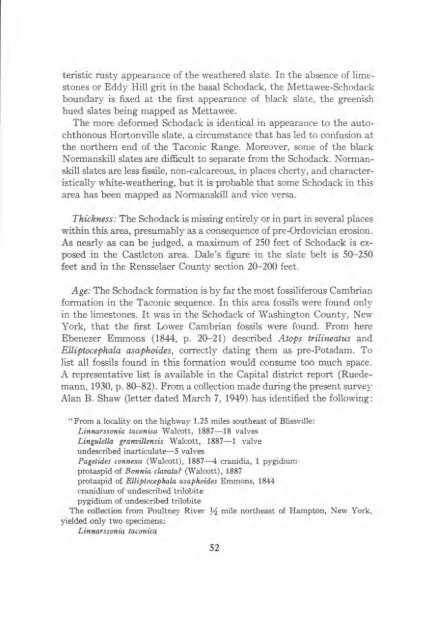STRATIGRAPHY AND STRUCTURE CASTLETON AREA VERMONT
STRATIGRAPHY AND STRUCTURE CASTLETON AREA VERMONT
STRATIGRAPHY AND STRUCTURE CASTLETON AREA VERMONT
You also want an ePaper? Increase the reach of your titles
YUMPU automatically turns print PDFs into web optimized ePapers that Google loves.
teristic rusty appearance of the weathered slate. In the absence of limestones<br />
or Eddy Hill grit in the basal Schodack, the Mettawee-Schodack<br />
boundary is fixed at the first appearance of black slate, the greenish<br />
hued slates being mapped as Mettawee.<br />
The more deformed Schodack is identical in appearance to the autochthonous<br />
Hortonville slate, a circumstance that has led to confusion at<br />
the northern end of the Taconic Range. Moreover, some of the black<br />
Normanskill slates are difficult to separate from the Schodack. Normanskill<br />
slates are less fissile, non-calcareous, in places cherty, and characteristically<br />
white-weathering, but it is probable that some Schodack in this<br />
area has been mapped as Normanskill and vice versa.<br />
Thickness: The Schodack is missing entirely or in part in several places<br />
within this area, presumably as a consequence of pre-Ordovician erosion.<br />
As nearly as can be judged, a maximum of 250 feet of Schodack is exposed<br />
in the Castleton area. Dale's figure in the slate belt is 50-250<br />
feet and in the Rensselaer County section 20-200 feet.<br />
Age: The Schodack formation is by far the most fossiliferous Cambrian<br />
formation in the Taconic sequence. In this area fossils were found only<br />
in the limestones. It was in the Schodack of Washington County, New<br />
York, that the first Lower Cambrian fossils were found. From here<br />
Ebenezer Emmons (1844, p. 20-21) described Atops trilineatus and<br />
Elliptocephala asaphoides, correctly dating them as pre-Potsdam. To<br />
list all fossils found in this formation would consume too much space.<br />
A representative list is available in the Capital district report (Ruedemann,<br />
1930, p. 80-82). From a collection made during the present survey<br />
Alan B. Shaw (letter dated March 7, 1949) has identified the following:<br />
'From a locality on the highway 1.25 miles southeast of Blissville:<br />
Linnarssonia taconica Walcott, 1887-18 valves<br />
Lingulella granvillensis Walcott, 1887-1 valve<br />
undescribed inarticulate-5 valves<br />
Pagetides connexa (Walcott), 1887-4 cranidia, 1 pygidium<br />
protaspid of Bonnie clavata? (Walcott), 1887<br />
protaspid of Elliptocephala asaphoides Emmons, 1844<br />
cranidium of undescribed trilobite<br />
pygidium of undescribed trilobite<br />
The collection from Poultney River 3/2 mile northeast of Hampton, New York,<br />
yielded only two specimens:<br />
Linnarssonia taconica<br />
52













